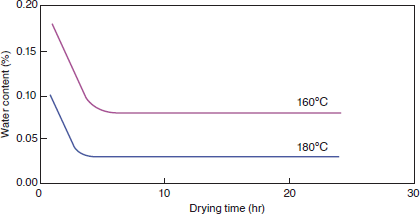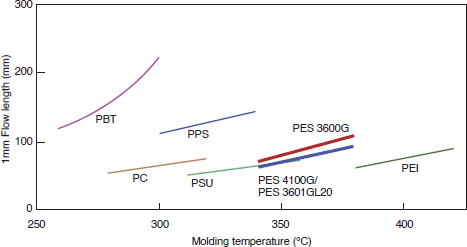- 製品情報
- スミカエクセル™ PES
- 射出成形条件
スミカエクセル™ PES及びスミプロイの射出成形条件
成形条件
スミカエクセルPESとスミプロイの標準的な成形条件を示します。
表4-1-1 スミカエクセルPESの標準的な成形条件
| グレード | 3600G 4100G |
4800G | 3601GL20 / 3601GL30 4101GL20 / 4101GL30 ES5340 |
||||
|---|---|---|---|---|---|---|---|
| 推奨条件 | 条件範囲 | 推奨条件 | 条件範囲 | 推奨条件 | 条件範囲 | ||
| 乾燥温度(℃) | 160~180 | 160~180 | 160~180 | ||||
| 乾燥時間(hr) | 5~24 | 5~24 | 5~24 | ||||
| シリンダ温度(℃) | 後部 | 320 | 300~340 | 320 | 320~340 | 320 | 300~340 |
| 中央部 | 340 | 320~370 | 340 | 330~370 | 340 | 320~370 | |
| 前部 | 350 | 330~380 | 360 | 340~390 | 350 | 330~380 | |
| ノズル | 350 | 330~380 | 360 | 340~390 | 350 | 330~380 | |
| 最適な樹脂温度(℃) | 350 | 350~360 | 360 | 350~370 | 350 | 350~360 | |
| 金型温度(℃) | 140~180 | 120~180 | 140~180 | 120~180 | 140~180 | 120~180 | |
| 射出圧力(MPa) | 100~200 | 100~200 | 100~200 | 100~200 | 100~200 | 100~200 | |
| 射出速度 | 低速 | 低速~中速 | 低速 | 低速~中速 | 低速 | 低速~中速 | |
| スクリュ回転数(rpm) | 50~100 | 50~100 | 50~100 | 50~100 | 50~100 | 50~100 | |
| スクリュ背圧(MPa) | 5~10 | 5~10 | 5~10 | 5~20 | 5~10 | 5~10 | |
| 保持圧力(MPa) | 50~100 | 50~100 | 50~100 | 50~150 | 50~100 | 50~100 | |
表4-1-2 スミプロイの標準的な成形条件
| グレード | GS5620 CS5220 / CS5530 / CS5600 |
E3010 FS2200 |
CK3400 / CK3420 CK4600 |
||||
|---|---|---|---|---|---|---|---|
| 推奨条件 | 条件範囲 | 推奨条件 | 条件範囲 | 推奨条件 | 条件範囲 | ||
| 乾燥温度(℃) | 160 | 160~180 | 160 | 160~180 | 160 | 160~180 | |
| 乾燥時間(hr) | 8 | 5~24 | 8 | 5~24 | 5 | 5~24 | |
| シリンダ温度(℃) | 後部 | 320 | 320~340 | 320 | 300~340 | 380 | 360~400 |
| 中央部 | 340 | 330~370 | 340 | 320~370 | 390 | 370~410 | |
| 前部 | 360 | 340~390 | 350 | 330~380 | 390 | 380~420 | |
| ノズル | 360 | 340~390 | 350 | 330~380 | 400 | 380~420 | |
| 最適な樹脂温度(℃) | 360 | 340~390 | 350 | 350~360 | 400 | 380~420 | |
| 金型温度(℃) | 140~180 | 120~180 | 140~180 | 120~180 | 180 | 120~180 | |
| 射出圧力(MPa) | 100~200 | 100~200 | 100~200 | 100~200 | 100~200 | 100~200 | |
| 射出速度 | 低速 | 低速~中速 | 低速 | 低速~中速 | 低速 | 低速~中速 | |
| スクリュ回転数(rpm) | 50~100 | 50~100 | 50~100 | 50~100 | 50~100 | 50~100 | |
| スクリュ背圧(MPa) | 5~10 | 5~10 | 5~10 | 5~10 | 5~10 | 5~10 | |
| 保持圧力(MPa) | 100~200 | 50~200 | 50~100 | 50~150 | 100~200 | 50~200 | |
予備乾燥
スミカエクセルPESは吸水性があるため、十分乾燥する必要があります。熱風循環式オーブン、除湿乾燥機を使用し、160~180℃で5~24時間乾燥してください。棚段式オーブンを用いる場合は50mm以下の厚さに広げ乾燥してください。特に大型成形品を成形する際には180℃での乾燥を推奨します。
また、非強化品や大型成形の場合は、除湿乾燥機を使用することをお奨めします。ホッパードライヤを使用する場合は、十分な容量があり熱容量の大きいものが必要です。予備乾燥が不十分な場合、成形品表面にシルバーストリークやフラッシュマーク等が現れることがあります。
上記のような現象が発生した場合は、さらに乾燥が必要です。
スミカエクセルPESは加水分解しないため上記の条件下での乾燥による劣化はありません。
図4-1-1 4100Gの乾燥曲線

樹脂温度
樹脂温度として330~380℃を推奨します。スミカエクセルPESは溶融粘度が高いため、せん断発熱によりシリンダ温度設定値に比べ樹脂温度が高くなる傾向があり、40℃以上差が生じる場合があります。樹脂温度を確認しながら成形を行う必要があります。
図4-1-2 PESの流動長(1mm)

樹脂の滞留時間
シリンダ内に滞留する時間の長さは、射出成形品の品質に大きな影響を与えます。滞留時間は、10分以下になるようにしてください。滞留時間が長くなると熱劣化を起こす可能性が高くなり、その結果として変色や黒条、あるいは黒点が成形部品に混入したりします。
金型温度
金型温度は表面温度が120~180℃になるように設定してください。また、金型表面の温度分布が小さくなるように設計してください。
金型温度が低すぎると、残留応力による成形品の反りやクラック(割れ)が発生します。ガラス繊維強化グレードでは、ガラス繊維の浮き出しの原因になります。金型温度を高く設定することにより、残留応力の少ない成形品が得られます。ただし金型温度が高すぎると、成形品取り出し時の変形の原因となります。
加熱方法としては、ヒータ方式・オイル温調方式のいずれも使用できますが、複雑形状金型、深物金型およびスライドコアのある金型では、オイル温調方式を使用し、金型温度分布をできるだけ小さくしてください。
特に大型成形の場合や非強化品を使用する成形の際には、金型温度に十分な注意を払う必要があります。
射出圧力、保持圧力
一般的にスミカエクセルPESの成形では高い射出圧力が要求され、100~200MPaの射出圧力が必要です。薄肉成形品やガラス繊維強化グレード、流動長の大きい成形品は、150MPa以上の射出圧力が必要です。
保持圧力は射出圧力の1/2~1/3に設定することを推奨します。ヒケが発生しない程度に保圧を低めに設定してください。保持圧力が低い方が、残留応力の少ない成形品を得られます。
ピーク圧力や保持圧力が高い程、離型しにくくなる傾向があるため、V-P切替位置を調節してピーク圧が上昇しすぎないようにしてください。
射出速度
スミカエクセルPESは一般的に低速~中速の射出速度が適していますが、成形品形状により最適な射出速度は異なります。
スミカエクセルPESは溶融粘度が高いため、射出速度が速すぎると、せん断発熱やエアの断熱圧縮によるヤケやシルバーの原因になります。
一方、薄肉成形品(1mm以下)や流動距離の長い成形品では、速い射出速度が必要になります。一般的には射出速度を低速にした方が、残留応力の少ない成形品が得られます。
スクリュ回転数、背圧
せん断発熱による樹脂温度上昇を防ぐため、スクリュ回転数は低速が好ましく、50~100rpmを推奨します。
適当な背圧をかけることにより、均一な溶融状態となります。背圧は5~10MPaが好ましく、分子量の高いグレードは、高めの背圧を設定してください。ただし、高すぎると樹脂の加熱や過負荷等の問題がおこる可能性があります。
成形の一時停止
成形を一時休止する場合には、樹脂の熱劣化を防止するためシリンダ温度は250~260℃に設定してください。樹脂温度が250℃未満になると、スクリュ表面やシリンダ内壁を損傷したり、成形再開後の異物発生の原因になる恐れがあります。長時間休止する場合にはシリンダ内をパージ材でパージしてからシリンダ温度を下げてください。
パージ方法
スミカエクセルPESご使用時のパージ方法について、説明いたします。
パージ材としては、MFRが0.05程度の高分子量ポリエチレンまたはポリカーボネート、もしくは、それらのガラス繊維強化グレードが適しています。
- 加工温度が高いため、発煙、ガス噴出、樹脂の飛散等があることを十分に考慮してください。
- パージ材をシリンダ内で滞留させないようご注意ください。
表4-1-3 スミカエクセルPESへの切り替え
| 項目 | 推奨条件 | |
|---|---|---|
| 設定 | 背圧 | 高め(スクリュがゆっくり後退する程度にしてください。) |
| スクリュー回転数 | 先行樹脂の成形時と同一の回転数にしてください。 | |
| 洗浄手順 | 1. 先行樹脂の排出 | ホッパー内とシリンダ内の先行樹脂をできる限り排出してください。 |
| 2. パージ材投入とパージ方法 | 先行樹脂の成形温度のまま、パージ材を投入して十分にパージしてください。 パージ材はポリカーボネートや高分子量ポリエチレンが適しています。洗浄効果を上げるためにガラス繊維強化のパージ材をご使用になる場合には、ノンフィラーパージ材に置換いただいた後に、PESに置換して下さい。 ガラス繊維が残らないように十分ご注意ください。 |
|
| 3. 温度変更 | パージ材を流しながら、PESの成形温度に変更してください。 | |
| 4. パージ材排出とPES投入 | PESの成形温度に達した時点でパージ材を十分に排出し、PESを投入してパージしてください。 | |
| 5. 成形 | PESでパージした後、シリンダー温度が安定したら成形可能になります。 | |
残留応力の確認
スミカエクセルPESは成形品の残留応力により、離型時に割れたり、クラック発生等の不具合が生じます。保持圧力や保圧時間を調整して、ヒケや過充填にならないように最適な条件にしてください。
スミカエクセルPESの射出成形品の残留歪を調べる方法として、以下の方法が使用できます。またこの方法は、最適成形条件の決定手段としても使用できます。
- テスト方法
- 成形品を室温まで放冷する。
- 成形品をキシレン中に90秒浸せきする。
- 冷水中で洗浄する。
- 成形品にクラックがないか良く確認する。
- クラックがなければ、トルエン中にて同様の試験を行う。以下溶剤を酢酸エチル、メチルエチルケトンの順に変えて行う。
- クラックが発生したら、その溶剤にて数個の成形品で試験を行い確認する。
表4-1-4 スミカエクセルPESの残留応力の確認方法(4100G)
| 溶剤 | 残留歪 | 残留応力 |
|---|---|---|
| キシレンでクラック発生 | 1.3~1.5%以上 | 30~40MPa以上 |
| トルエンでクラック発生 | 1.0%以上 | 27MPa以上 |
| 酢酸エチルでクラック発生 | 0.50%以上 | 14MPa以上 |
| メチルエチルケトンでクラック発生 | 0.35%以上 | 10MPa以上 |
